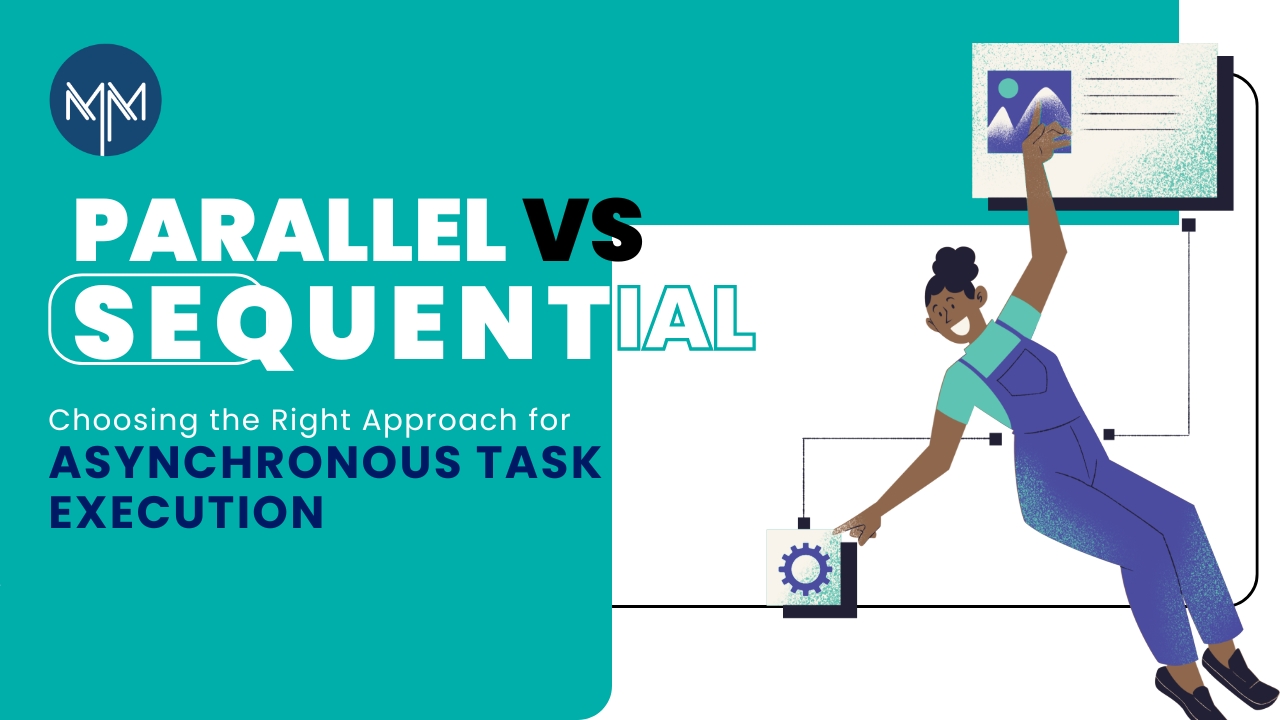The key to gaining a competitive edge for business through web development means keeping your users engaged. Asynchronous programming, where tasks don’t hold up the main thread, is a powerful tool to achieve this.
But within asynchronous programming, a crucial decision arises: sequential or parallel execution?
Before diving into the comparison, it’s essential to understand what asynchronous task execution entails.
Demystifying Asynchronous Task Execution
Asynchronous task execution is a programming approach where tasks don’t block the main thread of an application.
Imagine a web page loading.
Traditionally, if it has to download images or data, the entire page would freeze until everything is finished.
Asynchronous execution lets the main thread continue handling user interactions while those downloads happen in the background. This keeps your app responsive and users engaged. It’s particularly useful for tasks that take time, like network requests or file I/O.
In addition, depending on the programming language being used, asynchronous task execution can be implemented via callbacks, promises, and async/await constructs. By managing tasks concurrently rather than sequentially, the main objective is to maintain the application’s responsiveness and efficiency.

Sequential Asynchronous Task Execution:
Sequential asynchronous task execution involves completing tasks in a predetermined order, one after the other. Every task doesn’t start until the one before it is finished. This method is simple and guarantees that the task is done in a regulated manner.
This approach offers several benefits:
- Simplicity: Sequential code is easier to reason about and debug. Studies show context switching between tasks can incur a performance overhead of 100s or even 1000s of CPU cycles 1. Sequential execution avoids this overhead.
- Maintainability: When the output of one task feeds into the next, sequential code is easy to maintain.
- Predictable Order: Tasks are executed in a defined order, which can be crucial for operations that depend on the results of previous tasks.
- Resource Management: Since tasks are executed one at a time, the application can avoid issues related to resource contention and concurrency, such as race conditions and deadlocks.
However, the downside is potential sluggishness. If tasks involve waiting for external resources like network requests, the entire program might seem unresponsive.
Studies reveal that even a 1-second delay in page load time can result in a 7% drop in conversions. Therefore, if an online retailer makes $50,000 per day, that extra second of latency adds up to almost $1 million in lost revenue annually.
Parallel Execution: A Multi-Chef Approach
Using multi-core processors and other system resources to run many processes concurrently speeds up job completion. This technique is known as parallel asynchronous task execution. Performance can be greatly increased with this method, but concurrent operation management becomes more difficult.

Advantages of Parallel Execution
- Improved Performance: By executing tasks concurrently, applications can complete multiple operations in a fraction of the time it would take sequentially. This is particularly beneficial for I/O-bound and CPU-bound tasks.
- Better Resource Utilization: Parallel execution makes better use of system resources, including CPU and memory, by keeping multiple cores and threads active.
- Scalability: Applications designed for parallel execution can scale more effectively, handling increased workloads without significant performance degradation.
As an entrepreneur, developing a website for competitive advantage seems demanding but it can be overwhelming as well. The differences between sequential and parallel can be confusing when it comes to your website. Therefore, Matrix Media is here to help you. To make it easier for you to understand, we are going to provide a comparable table between sequential and parallel task execution.
As an entrepreneur, developing a website for your business can be demanding, yet overwhelming. The differences between sequential and parallel task execution can be confusing.
To simplify your decision-making, we’ve provided a professional comparison table between sequential and parallel task execution.
Let’s take a look:
| Feature | Sequential Programming | Parallel Programming |
| Execution style | Tasks run one after another in a strict order. | Tasks are divided into independent subtasks that can run concurrently (at the same time). |
| Hardware Utilization | Utilizes a single processor core at a time. | Can leverage multiple processor cores for improved performance. |
| Task Dependencies | Well-suited for tasks with dependencies, where the output of one task is needed for the next. | Requires independent tasks that don’t rely on each other’s data. |
| Complexity | It is simpler to write and debug due to the linear execution flow. | It can be more complex due to potential conflicts when accessing shared resources and the need for synchronization mechanisms. |
| Performance | It can be slower for applications with long-running tasks that involve waiting for external resources. | Offers potential for significant performance gains for applications with independent, long-running tasks. |
| Example | Processing a list of items one by one. | Downloading multiple files simultaneously. |
| Context Switching | No context switching overhead. | May incur context-switching overhead when switching between tasks. |
Challenges and Considerations
While both sequential and parallel asynchronous task execution have their advantages, they also come with specific challenges and considerations.
Challenges of Sequential Execution
- Performance Limitations: Sequential execution can be slower, particularly for applications requiring high throughput, as each task waits for the previous one to complete.
- Underutilization of Resources: Sequential execution may not fully utilize system resources, leaving CPU cores idle while waiting for tasks to complete.
Challenges of Parallel Execution
- Complexity: Parallel execution introduces complexity in managing concurrent tasks, including synchronization, handling race conditions, and avoiding deadlocks.
- Resource Contention: Multiple tasks running simultaneously can lead to contention for shared resources, resulting in degraded performance or unexpected behavior.
- Debugging Difficulties: Debugging parallel programs can be challenging due to the non-deterministic nature of task execution and potential concurrency issues.
How to select the right approach?
Deciding between sequential and parallel asynchronous task execution depends on several factors, including the nature of the tasks, performance requirements, and available system resources.
Here are some tips to help you choose the right approach for your project:
- Determine Task Dependencies: Sequential execution is the safer option if tasks depend on each other’s outcomes. To improve performance, think about parallel execution for independent processes.
- Assess the Performance Requirements: Parallel execution can offer the required speed for applications where performance is crucial, like real-time analytics or high-frequency trading platforms. Sequential execution’s ease of use might be adequate for applications with lower performance requirements.
- Think about the System Resources: Look into the system’s available resources, such as the CPU, memory, and bandwidth of the network. Make sure your environment can manage the increased demand before implementing parallel execution, as this can strain system resources.
- Maintainability and Complexity in Balance: Consider your application’s maintainability and complexity. The performance advantages of parallel execution may be outweighed if it adds excessive complexity. Sequential execution’s ease of use is advantageous for simpler applications.
Hybrid Approaches: To clear the confusion!
In many cases, a hybrid approach that combines both sequential and parallel execution can offer the best of both worlds. For example, a developer might execute a group of independent tasks in parallel, and then process their results sequentially. This approach allows you to leverage the performance benefits of parallelism while maintaining control over task dependencies and order.

Example: Hybrid Approach in Web Scraping
Consider a web scraping application that needs to scrape data from multiple websites and then process the collected data sequentially. Here’s how a hybrid approach can be implemented:
- Parallel Scraping: Scraping data from multiple websites simultaneously reduces the total time spent on network operations.
- Sequential Processing: Once the data is collected, process the results sequentially to ensure that each step has the necessary data and to simplify the processing logic.
This approach maximizes efficiency by reducing the time spent waiting for network requests while maintaining a controlled and straightforward processing flow.
Conclusion
Choosing the right approach for asynchronous task execution—sequential or parallel—depends on a careful analysis of your application’s requirements and constraints.
Remember, asynchronous programming, regardless of sequential or parallel execution, is about keeping the main thread free. The best approach depends on your specific needs.
Matrix Media is here to help!
Our expertise will decode your business needs to determine the best approach for your website. Discuss your requirements with our developers.
Select Matrix Media Solutions to develop a robust website for your business in just a few months. Contact our experts for further guidance and support.


 May 24, 2024
May 24, 2024

